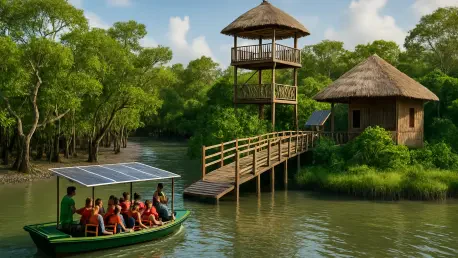Nestled in the delta region of India, the Sundarban Biosphere Reserve stands as a UNESCO World Heritage Site, celebrated for its sprawling mangrove forests and as the habitat of the majestic Royal Bengal Tiger. This ecological marvel, however, grapples with mounting threats from climate change, rising sea levels, and human encroachment, which jeopardize its delicate balance. A pioneering study recently published in Discover Artificial Intelligence showcases how artificial intelligence (AI) can evaluate the potential for ecotourism in this region, striving to harmonize conservation efforts with economic development. By harnessing cutting-edge technologies, this research illuminates a path toward sustainable tourism in areas of profound environmental significance, offering a glimpse into how innovation can safeguard natural treasures while supporting local livelihoods. The approach not only addresses immediate challenges but also sets a precedent for global conservation strategies.
Technology in Ecotourism Assessment
Harnessing AI Innovations
The application of AI in assessing ecotourism potential marks a transformative leap for environmental management in the Sundarbans. Deep learning and machine learning technologies are at the forefront, adeptly handling intricate datasets that encompass biodiversity markers, visitor behaviors, and environmental variables. These tools sift through vast amounts of information to pinpoint areas where tourism can be developed with minimal ecological disruption. Unlike conventional methods that often fall short due to subjectivity, AI provides a level of precision that enhances planning accuracy. For instance, algorithms can detect subtle patterns in species distribution or habitat health, ensuring that tourism zones do not encroach on critical ecosystems. This data-driven methodology offers a robust foundation for crafting strategies that protect the reserve’s unique biodiversity while opening avenues for responsible visitor engagement.
Another critical aspect of AI’s role lies in predictive modeling, a feature of machine learning that anticipates future trends and potential impacts of tourism on the Sundarbans. By analyzing historical data alongside real-time inputs, these models forecast fluctuations in visitor numbers and their possible effects on fragile environments. Such foresight allows planners to implement proactive measures, like setting visitor caps during peak seasons or designating temporary no-access zones to prevent stress on ecosystems. This capability to predict and adapt to changing conditions represents a significant advancement over reactive approaches, empowering stakeholders to mitigate risks before they escalate. The integration of these technologies underscores a shift toward preemptive conservation, ensuring that tourism growth aligns with the long-term health of the reserve.
Structured Decision-Making with MCDA
Multi-Criteria Decision Analysis (MCDA) emerges as a cornerstone in the study, providing a structured framework to evaluate the multifaceted aspects of ecotourism development. This method assesses a spectrum of factors, including economic viability, social implications, and environmental sustainability, ensuring that no single element overshadows the others. By assigning weighted values to each criterion based on scientific data and stakeholder priorities, MCDA facilitates a balanced approach to decision-making. In the context of the Sundarbans, this means that potential revenue from tourism is considered alongside the need to preserve mangrove ecosystems and support local communities. Such a comprehensive evaluation minimizes the likelihood of shortsighted policies that could harm the region’s ecological integrity in pursuit of immediate financial gains.
Beyond its analytical rigor, MCDA fosters inclusivity by integrating input from a diverse array of stakeholders, ranging from conservationists to local residents. This collaborative process ensures transparency and helps address potential biases that might skew outcomes if decisions were left to a narrow group. For the Sundarbans, stakeholder engagement through MCDA means that tourism plans reflect the realities faced by those living in the region, as well as the broader goals of environmental protection. This method contrasts sharply with traditional assessments, which often lack such a participatory element, risking alienation of key groups. By prioritizing a well-rounded and open decision-making process, MCDA paves the way for ecotourism initiatives that are both sustainable and widely supported, setting a model for other sensitive regions to emulate.
Community Engagement and Sustainability
Empowering Local Stakeholders
Central to the vision of sustainable ecotourism in the Sundarbans is the active involvement of local communities, whose intimate knowledge of the region proves invaluable. Residents, many of whom rely on the reserve for fishing and other resources, offer unique insights into its ecological nuances and cultural heritage. Their participation ensures that tourism initiatives are not only environmentally sound but also culturally respectful, aligning with local traditions and needs. Engaging these communities in planning and data collection helps tailor projects that resonate with their lived experiences, avoiding the pitfalls of externally imposed solutions. This approach builds trust and fosters a collaborative spirit, essential for the success of any long-term conservation effort in such a biodiverse and populated area.
The economic dimension of community involvement further amplifies its importance in the Sundarbans’ ecotourism framework. By spearheading activities like guided tours or selling locally crafted goods, residents gain direct financial benefits from tourism, creating alternative livelihoods that reduce dependency on resource-intensive practices. These initiatives also cultivate a sense of ownership over conservation efforts, as locals see tangible rewards from protecting their natural surroundings. Unlike top-down models that often exclude community input, this bottom-up strategy ensures that economic gains are equitably shared, reinforcing the social fabric of the region. Such empowerment not only bolsters sustainability but also serves as a buffer against the environmental pressures that threaten the reserve, making community engagement a linchpin of responsible tourism development.
Prioritizing Long-Term Ecological Goals
Ecotourism in the Sundarbans is framed as a vital tool for sustainable development, capable of generating revenue while safeguarding the region’s ecological health. The study highlights how well-planned tourism can raise awareness about conservation needs among visitors, turning them into advocates for the reserve’s protection. This dual benefit of economic growth and environmental education positions ecotourism as a strategic response to the challenges of habitat degradation and climate change. However, the emphasis remains on meticulous implementation to avoid overburdening ecosystems, with strict guidelines ensuring that visitor activities do not disrupt critical habitats like mangrove forests. Balancing these objectives requires a nuanced understanding of the reserve’s limits, a task that the research addresses through its data-driven insights.
A long-term focus underpins the study’s vision for ecotourism, with community engagement playing a pivotal role in ensuring lasting impact. By involving locals in the design and execution of tourism projects, initiatives are crafted to endure beyond short-term gains, supporting both environmental preservation and sustained livelihoods. This approach contrasts with fleeting economic boosts that often neglect ecological consequences, instead prioritizing resilience and adaptability. For instance, training programs for residents to become guides or conservation stewards embed skills that benefit the community for years to come. Such strategies anchor ecotourism in the broader goal of sustainability, ensuring that the Sundarbans remain a vibrant ecosystem and a source of pride for future generations, while still contributing to regional prosperity.
Global Implications and Future Directions
Replicating Success in Other Regions
The framework developed for assessing ecotourism potential in the Sundarbans holds significant promise as a replicable model for other biodiversity hotspots around the globe. By combining AI technologies with MCDA, the study offers a scalable approach that can be adapted to diverse environments, from the Amazon rainforest to Southeast Asian wetlands. Each region faces unique challenges, yet the core methodology—leveraging data-driven insights and balanced decision-making—provides a universal toolset for responsible tourism planning. This adaptability is crucial in a world where ecological threats are escalating, requiring innovative solutions that prioritize conservation without stifling economic opportunities. The Sundarbans case thus serves as an inspiring blueprint, demonstrating how technology can bridge the gap between preservation and progress on a global scale.
Implementing this framework in other areas, however, demands careful consideration of local contexts and available resources. While the Sundarbans benefit from a wealth of ecological data, many regions lack such comprehensive information, posing a barrier to AI-driven assessments. Future efforts must explore innovative data collection methods, such as remote sensing or community-based monitoring, to overcome these gaps. International partnerships could also play a role, pooling expertise and funding to support technology adoption in under-resourced areas. Addressing these challenges will ensure that the benefits of this approach are not confined to well-studied regions but extend to lesser-known ecosystems equally deserving of protection. The potential for widespread impact underscores the importance of refining and sharing this model across borders.
Innovating for Tomorrow’s Challenges
Looking ahead, the role of technology in environmental management is poised to expand, with AI tools evolving to offer even greater precision in managing tourism impacts. Advances in real-time analytics could enable dynamic adjustments to visitor policies in the Sundarbans, responding instantly to environmental changes or overcrowding risks. Such innovations promise to enhance the ability of stakeholders to safeguard sensitive areas while maximizing the benefits of ecotourism. Keeping pace with these developments requires ongoing investment in research and infrastructure, ensuring that tools remain accessible and relevant to conservation needs. This forward-thinking approach positions technology as a cornerstone of proactive environmental stewardship, ready to tackle emerging challenges with agility.
Collaboration remains a critical focus for the future, as the Sundarbans study highlighted the value of dialogue among governments, conservation organizations, and local communities. Resolving potential conflicts between economic interests and ecological priorities demands continuous engagement, fostering solutions that are both practical and equitable. Building on this foundation, future initiatives should prioritize interdisciplinary partnerships that blend technological expertise with on-the-ground insights. This collective effort can drive the refinement of ecotourism strategies, ensuring they adapt to global trends like climate change. The lessons drawn from this research serve as a compelling call to action, urging sustained commitment to protecting natural wonders through innovation and unity.









